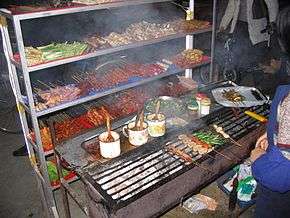Shaokao

Shaokao (Chinese: 烧烤, shāokǎo), also romanized as shao kao, is the Chinese translation of "barbecue". Chinese variants of the practice constitute a significant aspect of Chinese cuisine.[1] In China, it is predominantly found on busy Chinese streets and night markets as a street food sold in food stalls[2][3][4] and is a type of xiaochi. In China and elsewhere, such as in the United States, diners sometimes also order beer as an accompaniment.[2]
Shaokao typically consists of heavily spiced, barbecued foods on skewers. It is available in almost all of the cities in China, and is a prominent dish in Beijing, China, where some restaurants set up food stalls outdoors to purvey the product. Concerns about food safety associated with shaokao and air pollution generated from outdoor shaokao vendors associated with increased smog levels in Beijing have prompted complaints about the vendors.
Preparation
Shaokao is prepared with meats, fish and seafood, and vegetables on bamboo skewers that are flame grilled on a barbecue[5] after being heavily seasoned with various spices, including both cumin and Chinese five-spice powder.[2][6][7][8] The skewers can be cooked to order. Barbecue chicken legs and spare ribs are also some of the dishes in shaokao cuisine.[9]
Prominence
Shaokao can be found in almost all of the cities in China.[2] They are often located along streets that have a strip of bars.[8] In China, some shaokao food stalls also purvey other goods such as produce that are displayed hanging on sticks.[2] In China and the United States, some restaurants specialize in shaokao dishes.[2][10]
In Beijing
In Beijing, shaokao is a very common and popular food,[11] and some restaurants in Beijing set-up shaokao barbecues outside of the restaurants to purvey them to people walking on the streets.[2] Shaokao stands are sometimes operated by migrant workers in Beijing.[11] Shaokao stand operators are sometimes reported to the police in Beijing by neighbors who complain about the smoke and aroma that gets into homes, as well as about concerns about food poisoning that can occur from improper meat handling and cooking.[11] In 2013, outdoor barbecue stands were banned due to heavy smog conditions.[11] Chinese authorities have stated that shaokao operations and Chunjie fireworks are a significant cause of smog in Beijing.[11]
See also
References
- ↑ Chen, E. (1976). Introductory Traditional Chinese Regional Cuisine. Traditional Chinese regional cuisine. Esther Chen. p. 28. Retrieved May 23, 2016. (subscription required)
- 1 2 3 4 5 6 7 Kauffman, Jonathan (September 14, 2015). "The Chinese street food that's showing up in local restaurants". San Francisco Chronicle. Retrieved May 24, 2016.
- ↑ Kepnes, M. (2015). How to Travel the World on $50 a Day: Revised: Travel Cheaper, Longer, Smarter. Penguin Publishing Group. p. pt148. ISBN 978-0-698-40495-3. Retrieved May 23, 2016.
- ↑ Mayhew, B.; Miller, K.; English, A. (2002). South-West China. Lonely Planet Southwest China. Lonely Planet. p. 469. ISBN 978-1-86450-370-8. Retrieved May 23, 2016.
- ↑ Eimer, D. (2014). The Emperor Far Away: Travels at the Edge of China. Bloomsbury Publishing. p. pt278. ISBN 978-1-62040-364-8. Retrieved May 24, 2016.
- ↑ "Shao Kao (Street Barbeque)". Food Republik. 9 January 2010. Retrieved 22 January 2013.
- ↑ Planet, L. (2016). Lonely Planet Shandong, Jinan & Northeast China. Travel Guide Chapter. Lonely Planet Publications. p. pt226. ISBN 978-1-76034-284-5. Retrieved May 23, 2016.
- 1 2 Barys, Jamie (June 4, 2013). "Shanghai's best street foods and stalls". The Guardian. Retrieved May 24, 2016.
- ↑ Hoenig, A. (2010). Eating Out in China: A Traveler's Resource. EZChinesey Guides. Ezchinesey.com. p. 296. ISBN 978-0-9822324-2-2. Retrieved May 23, 2016.
- ↑ Network, M.; Miller, D.S. (2014). 101 Places to Get F*cked Up Before You Die: The Ultimate Travel Guide to Partying Around the World. St. Martin's Press. p. 95. ISBN 978-1-250-03559-2. Retrieved May 23, 2016.
- 1 2 3 4 5 Wolf, Daniel (December 5, 2014). "Healthcare hell in smog-filled China". Financial Review. Retrieved May 24, 2016.
Further reading
- Lee, P.Y. (2004). 250 Essential Chinese Characters for Everyday Use 2. C. E. Tuttle. p. 217. ISBN 978-0-8048-3360-8. Retrieved May 23, 2016.
